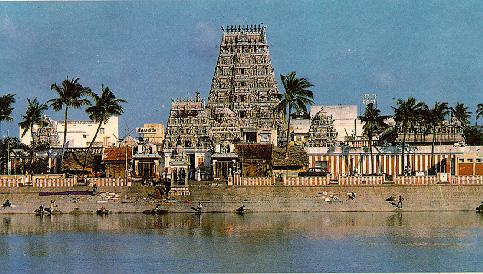Abodes of Ganesha
Temples of Tamilnadu
|

Maargazhi Musings
December 17, 2000Thoughts on the 30 day festival season in Tamilnadu, awaiting the arrival of the winter solstice through the darkest month of the year.
The word Maargazhi brings to mind memories of childhood music classes, when our teacher would abruptly stop teaching kritis and switch over to Tiruppaavai. It was our first ever formal introduction to the world of Tamil hymns of the Bhakti movement that revolutionized and revitalized the religion of the Indian subcontinent towards the end of the 1st millennium CE.
I went back home that day, some 28 years back, with a child's sense of exhuberence. Here was music whose lyrics I could understand. Here was music, whose solfege did not have to be written. There was another bonus. The lyrics did not need to be written down either. A yellowed book with a missing cover page was handed to me by the ever gracious teacher.
All the 12 classes, in the month of Maargazhi that year, were devoted to Tiruppaavai. So were the classes in the Maargazhis that followed in subsequent years.
Then there was the Tiruppaavai, Tiruvempaavai recitation/singing competitions. Maale Mani Vanna in Kuntalavaraali was the most sung Tiruppaavai in the competition - where I also had my first exposure to Tiruvempaavai, at the Kachabeswarar Temple in the now virtually uninhabitable Parrys Corner, in Chennai.Now, why did the kids that sang Tiruvempaavai, sing all of the hymns in Bhoopaalam. Why werent there other raagams in the Tiruvempaavai hymns sung in the competition? It was only later that we were to learn that the currently popular tunes, in which the lyrics of Tiruppaavai are sung, are thanks to the efforts of veteran Karnatic musician Ariyakkudi Raamanuja Iyengaar.
An image of Maanikkavaacakar was taken in procession, for a 10 day period culminating in Tiruvaadirai. Four different processions of Manikkavaacakar were encountered each day in our neighborhood, each bearing the image of the poet Saint in four different types of palanquins, to the accompaniment of four different nadaswaram troupes, and at times, four sets of Oduvaars.
The results of the competition were announced in the month of Thai, following the monthlong Maargazhi . 'Ki Vaa Ja' - was the big name, that was to grace the occasion, with a speech. He was to award a specially pressed coin and a book as a consolation prize to every single participant. 'A great speaker he was' we were told. 'Do you know Kalaimagal? He runs that magazine' - 'Oh, Kalaimagal' - were the murmured conversations, as the fifty odd kids sat in silence, in front of a packed stage, in a packed temple courtyard.
28 years later, I still remember two interesting details regarding these Classics, that the veteran writer pointed out in his lecture to kids and adults then. 'The first hymn Tiruppaavai begins with the syllable Maa (Maargazhi Tingal) - the syllable, with which Maanikkavaacakar's name begins - while the first hymn in Tiruvempaavai begins with the syllable Aa, with which Aandaal's name begins. 'The stalwarts of Vaishnavism and Saivism had thus acknowledged each other', he said. We thought it was neat. He also spoke of a tradition of Tiruppaavai/Tiruvempaavai singing in Indonesia - where the chanters concluded each verse with emphasis on the phrase 'lorepmaavai' given their lack of knowledge of Tamil!
In the following year, as we moved elsewhere in George Town, strains of a lady's voice singing the Tamil hymns used to waft through and wake us up in the morning. That was when I realized, that the hymns of Tiruvempaavai were being rendered in 20 different raagams, just like the Tiruppaavai hymns. I was to learn later, during the Navaratri of 1974 - in the Madurai Meenakshi Sundareswarar temple that this lady was none other than the veteran Karnatic Musician MLV.
It amazes me to see these Maargazhi festival traditions fairly intact, in an era, where the rapid changes brought about through the information revolution, have changed the face of various festival traditions. Contrast this for example with Deepavali of 1997 that I spent at Anna Nagar, Chennai. I could very well have been at Annapolis, Maryland! It turned out that we were the only ones celebrating Deepavali at 5 AM in the neighborhood! 'Oh! Today is a holiday. We need to catch up on sleep. We shall celebrate the occasion in the evening' - was the reason that justified the lack of early morning Deepavali celebration.
Thus, in Maargazhi 1997 (98), when I strolled to Kapaaleeswarar temple, in the wee hours of the morning on Vaikuntha Ekaadasi. Maanikkavaacakar, was then just being placed on his palanquin (which was to be wheeled through the processional streets of Tirumayilai); a sole Oduvaar, with a pair of cymbals, accompanied the image with a nadaswaram and a drum player. Inside the temple, there was a flurry of activity, with the early risers, scrambling for a darshan to the temple, before leaving for their work.
The brilliant lights of the billboards of leading restaurants such as Sangeeta , flanked by scores of coconut trees, and the still water filled Mylapore tank, all enveloped by the now brightening sky greeted me as I walked along the Western wall of the temple.
My next stop was at the Kesava Perumaal temple - where an orderly crowd waited in a perfectly formed long line for a walk through the Vaikuntha Vaasal, to have a darshan of Mahaavishnu on Vaikuntha Ekaadasi. Processions of Perumaal on the Garuda mount, were received enthusiastically by traditionally dressed neighbors in the vicinity, with offerings of coconuts and the like.
The amount of activity in the wee hours of dawn was quite astounding, in contrast to the rest of the walk back home, where late risers, armed with toothbrushes and hand towels, adorned balconies of multi-family dwellings, again preparing to continue with the dance of life, in what would be another day in Maargazhi.See Also:
